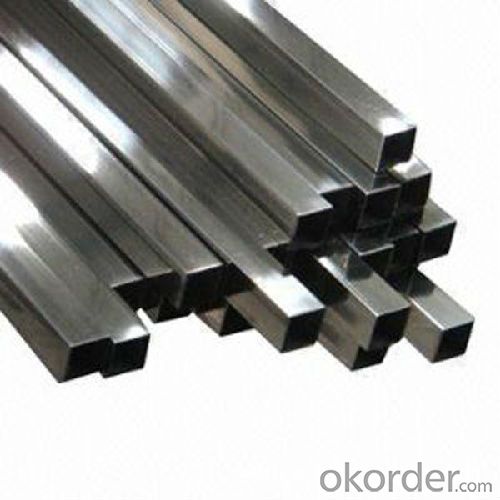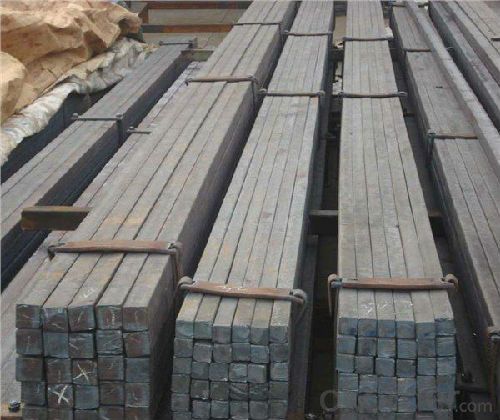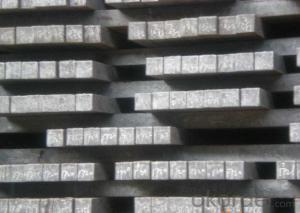High quality steel billet product Q195 Q35
- Loading Port:
- Shanghai
- Payment Terms:
- TT or LC
- Min Order Qty:
- 25 m.t.
- Supply Capability:
- 20000 m.t./month
OKorder Service Pledge
OKorder Financial Service
You Might Also Like
Product Description:
OKorder is offering high quality Hot Rolled Steel I-Beams at great prices with worldwide shipping. Our supplier is a world-class manufacturer of steel, with our products utilized the world over. OKorder annually supplies products to European, North American and Asian markets. We provide quotations within 24 hours of receiving an inquiry and guarantee competitive prices.
Product Applications:
1) Suitable for making various strong cutting tool abrasion resistance, impact resistance.
2) Used to produce all kinds of high hard and super hard saw blade, drill, tap, broach, gear hob and various kinds of milling cutter.
3) Used for advanced punching die, screw die, and the toughness and complicated shape of the punch, etc.
4) Is used for cold forging die and drawing mode, etc.
5) Recommended watchcase factory, screw factory and other cold stamping products industry use.
Product Advantages:
OKorder's Steel I-Beams are durable, strong, and resist corrosion.
Main Product Features:
· Premium quality
· Prompt delivery & seaworthy packing (30 days after receiving deposit)
· Corrosion resistance
· Can be recycled and reused
· Mill test certification
· Professional Service
· Competitive pricing
Product Specifications:
Standard: GB,
-Grade: Q195 or equivalent.
-Chemical Composition:
Standard | Grade | Element (%) | ||||
GB | Q195 | C | Mn | S | P | Si |
0.06~0.12 | 0.25~0.50 | ≤0.050 | ≤0.045 | ≤0.30 | ||
Measures of HR Square Bar (small measures):
(Section of HR Square Bar)
-Length of a side and Theoretical weight of Square Bar.
Length of a side(mm) | Theoretical weight(kg/m) | Length of a side(mm) | Theoretical weight(kg/m) |
7 | 0.385 | 22 | 3.80 |
8 | 0.502 | 24 | 4.52 |
9 | 0.636 | 25 | 4.91 |
10 | 0.785 | 26 | 5.30 |
11 | 0.950 | 28 | 6.15 |
12 | 1.13 | 30 | 7.06 |
13 | 1.33 | 32 | 8.04 |
14 | 1.54 | 34 | 9.07 |
15 | 1.77 | 36 | 10.17 |
16 | 2.01 | 38 | 11.24 |
17 | 2.27 | 40 | 12.56 |
18 | 2.54 | 42 | 13.85 |
19 | 2.82 | 45 | 15.90 |
20 | 3.14 | 48 | 18.09 |
21 | 3.46 | 50 | 19.63 |
Notes:
1, The theoretical weights in the list, base on the density of 7.85 g/cm3.
2, Formula for theoretical weight of Square bar: (length of a side)2 * 0.00785
3, The numbers with *mean that they are not regular or we don’t offer them.
-Regular length of Square Bar:
Steel | Length of a side (mm) | Length of steel (m) |
Normal steel | < 25 | 4~10 |
> 25 | 3~9 | |
Steel of high quality | All measure | 2~6 |
Tool steel >75 | 1~6 |
FAQ:
Q1: Can stainless steel rust?
A1: Stainless does not "rust" as you think of regular steel rusting with a red oxide on the surface that flakes off. If you see red rust it is probably due to some iron particles that have contaminated the surface of the stainless steel and it is these iron particles that are rusting. Look at the source of the rusting and see if you can remove it from the surface.
Q2: How do you package the angle steel when shipping?
A2: All goods are packed in bundles with steel strips and shipped by container or break bulk.
Q3: The products are invoicing on theoritical weight or on actual weight?
A3: We can do it in both manners, according to the customers' request.


- Q:What are the potential applications of steel billets in the electronics aftermarket?
- Steel billets have numerous potential applications in the electronics aftermarket. One possible application is the production of electronic enclosures or casings. Steel billets can be machined and shaped into various forms and sizes to create sturdy and reliable enclosures that protect electronic components. These enclosures provide durability and protection against environmental factors such as moisture, dust, and impact. Additionally, steel billets can be used in the manufacturing of various electronic components. For example, they can be utilized to create connectors, pins, sockets, and other small parts that are essential for electronic devices. Steel's high strength and conductivity make it an ideal material for these components, ensuring reliable performance and efficient signal transmission. Furthermore, steel billets can be employed in the production of heat sinks for electronic devices. Heat sinks are crucial in dissipating heat generated by electronic components and preventing overheating, which can lead to performance issues or even component failure. Steel's excellent thermal conductivity makes it a suitable material for heat sinks, allowing efficient heat transfer and ensuring the proper functioning of electronic devices. Moreover, steel billets can be utilized in the manufacturing of racks and cabinets used for housing and organizing electronic equipment. These structures provide a safe and secure environment for storing and accessing electronic devices in various settings, such as data centers, telecommunications facilities, or server rooms. Steel's durability and load-bearing capabilities make it an ideal choice for such applications, ensuring the protection and organization of electronic equipment. In summary, steel billets have a range of potential applications in the electronics aftermarket. Whether it is in the production of enclosures, electronic components, heat sinks, or racks and cabinets, steel's strength, conductivity, durability, and thermal properties make it a versatile material for various electronic applications.
- Q:What are the challenges faced in the distribution and supply chain of steel billets?
- The distribution and supply chain of steel billets encounter several challenges. Firstly, transportation poses a major obstacle due to the heavy and bulky nature of steel billets. Specialized equipment and infrastructure are necessary, which can result in higher logistics costs and difficulties in finding suitable transport options, particularly for international shipments. Secondly, the storage and inventory management of steel billets present challenges. Proper storage facilities are required to prevent corrosion and damage. Moreover, managing inventory levels and ensuring timely deliveries become complex as steel billets are sourced from multiple suppliers and delivered to various locations. Thirdly, maintaining quality control is a significant challenge. Consistent quality throughout the supply chain demands strict adherence to quality standards and effective quality control measures. Regular inspections, testing, and certification processes are necessary to ensure the integrity and suitability of the steel billets. Another challenge stems from fluctuating demand and market conditions. The steel industry is highly cyclical, with demand and prices influenced by economic fluctuations and global market trends. Consequently, forecasting demand, managing production capacity, and optimizing inventory levels to meet customer requirements while minimizing costs become difficult. Furthermore, global trade regulations and customs procedures create challenges. Compliance with various import and export regulations, including trade restrictions and tariffs, can affect the flow of steel billets across different countries, leading to delays and additional costs. Lastly, ensuring sustainable and responsible sourcing practices is increasingly important. Meeting environmental and social standards, such as responsible sourcing of raw materials and reducing carbon emissions, poses challenges for steel billet manufacturers and distributors. Implementing sustainable practices throughout the supply chain may involve additional costs and complexities. In conclusion, the distribution and supply chain of steel billets face challenges related to transportation, storage, quality control, demand fluctuations, trade regulations, and sustainable sourcing. Overcoming these challenges necessitates effective planning, strong partnerships, and the implementation of efficient processes to ensure a smooth and reliable supply of steel billets to customers.
- Q:What are the different surface defects that can occur during steel billet production?
- Some of the different surface defects that can occur during steel billet production include cracks, laps, seams, scabs, surface porosity, and scale.
- Q:Can steel billets be used for making cutlery?
- Steel billets have the potential to be utilized in the creation of cutlery. These billets serve as the primary substance in the manufacturing of a variety of steel commodities, which encompass cutlery. Once heated, the billets are then transformed into desired forms, such as knives, forks, or spoons, through methods like forging or casting. The resultant steel cutlery possesses notable attributes such as strength, durability, and the ability to maintain a sharp edge. Nevertheless, it is important to recognize that the specific kind of steel employed and the manufacturing procedures substantially influence the quality and characteristics of the cutlery.
- Q:What are the different types of steel billet casting processes?
- There are various steel billet casting processes available, each with its own set of advantages and disadvantages. Continuous casting, ingot casting, and direct chill casting are some of the commonly used methods. Continuous casting is a widely employed technique where molten steel is poured into a water-cooled mold, resulting in a continuous strand or billet. This method offers several benefits such as high production rates, improved quality control, and reduced energy consumption. It is particularly suitable for producing large quantities of steel billets with consistent dimensions. Ingot casting, on the other hand, is an older and less frequently utilized method. It involves pouring molten steel into individual molds known as ingot molds, which solidify into solid blocks or ingots. These ingots are then reheated and shaped into billets through processes like rolling or forging. Ingot casting allows for more flexibility in terms of alloy composition and size, but it generally requires more energy and has a slower production rate compared to continuous casting. Direct chill casting is another popular process, especially for aluminum alloys. It shares similarities with continuous casting, as molten steel is poured into a water-cooled mold. However, the main difference lies in the use of a rotating mold in direct chill casting, resulting in cylindrical or rectangular billets. This method provides better control over the solidification process, leading to improved microstructure and mechanical properties. Less common steel billet casting processes include electromagnetic casting, where an electromagnetic field is employed to control the flow of molten steel, and centrifugal casting, which involves pouring molten steel into a rotating mold to create cylindrical billets. These methods are typically utilized for specialized applications and are not as widely adopted as continuous casting or ingot casting. In conclusion, the various steel billet casting processes include continuous casting, ingot casting, direct chill casting, electromagnetic casting, and centrifugal casting. Each method offers unique advantages and is suitable for different production requirements and steel grades. The choice of casting process depends on factors such as desired billet size, production volume, alloy composition, and cost considerations.
- Q:How do steel billets contribute to the manufacturing of furniture?
- Steel billets are an essential raw material in the manufacturing of furniture as they are used to create sturdy and durable frames, legs, and supports. The billets are melted down and shaped into various forms, allowing furniture manufacturers to produce high-quality and robust pieces that can withstand heavy loads and regular use.
- Q:How are steel billets used in the manufacturing of fasteners?
- Fasteners are devices utilized for the purpose of joining or securing multiple objects together, and steel billets play a vital role in their production. These billets serve as the primary material from which fasteners are created. Typically, steel billets possess a square or rectangular shape and are considered semi-finished products. To produce them, molten steel is poured into molds and allowed to cool and solidify through a process known as casting. Once the steel billets have been obtained, they undergo a series of manufacturing procedures to transform them into fully functional fasteners. These procedures encompass hot rolling, cold drawing, and machining. The initial step involves hot rolling, in which the steel billets are subjected to high temperatures and passed through a set of rollers. This process enables the billets to take on the desired shape of long, cylindrical bars or rods with a specific diameter. Following hot rolling, the bars undergo cold drawing. This process entails pulling the bars through a series of dies to reduce their diameter and enhance their surface finish. Additionally, cold drawing contributes to improving the mechanical properties of the steel, rendering it stronger and more resilient. Finally, the steel bars are machined to create fasteners with precise designs. This involves cutting, threading, and forming the bars into bolts, screws, nuts, or other types of fasteners. Subsequently, the machined fasteners undergo heat treatment processes such as quenching and tempering to further enhance their strength and hardness. In summary, steel billets hold immense importance in the manufacturing of fasteners as they serve as the raw material that undergoes various transformation processes. Through hot rolling, cold drawing, and machining, steel billets are shaped into the desired form, resulting in high-quality fasteners that meet industry standards.
- Q:What are the different surface treatments applied to alloy steel billets?
- Enhancing the properties and performance of alloy steel billets can be achieved through various surface treatments. One commonly used treatment involves bombarding the billet surface with small metal or ceramic particles at high velocity, a process known as shot blasting. This effectively eliminates impurities and contaminants, resulting in a clean and uniform surface finish. Additionally, shot blasting promotes the adhesion of subsequent coatings or treatments. Another method, known as pickling, entails immersing the billets in an acid solution to remove oxides and scale from the surface. This not only improves the surface quality but also eliminates any defects, preparing the billets for further processing or treatments. Heat treatment is a popular surface treatment for alloy steel billets. By subjecting the billets to controlled heating and cooling processes, their microstructure can be altered, leading to improved mechanical properties. This treatment can enhance the hardness, strength, and toughness of the billets, rendering them more suitable for specific applications. Furthermore, alloy steel billets can be coated with protective coatings to enhance corrosion resistance and durability. Common techniques include hot-dip galvanizing, electroplating, and painting. These coatings serve as a barrier between the alloy steel surface and the environment, effectively preventing corrosion and extending the lifespan of the billets. To summarize, shot blasting, pickling, heat treatment, and protective coatings are among the various surface treatments applied to alloy steel billets. These treatments enhance surface quality, improve mechanical properties, and protect against corrosion, ensuring optimal performance in diverse applications.
- Q:How are steel billets used in the manufacturing of electrical components?
- The advantageous properties and suitability of steel billets make them commonly used in the manufacturing of electrical components. This process begins by producing steel billets, which are solid rectangular or square bars of steel formed through casting or hot rolling. When manufacturing electrical components, steel billets act as the raw material that undergoes various processes to become specific components. An example of this is the production of transformer cores, which are essential components in electrical transformers. Transformer cores made from steel billets offer high magnetic permeability, low hysteresis loss, and low electrical conductivity, making them perfect for magnetic induction applications. To manufacture transformer cores, the steel billets are heated and then shaped into thin laminations by passing them through a series of rolling mills. These laminations are stacked together and insulated with materials like varnish or paper, creating a core that efficiently transfers electrical energy between coils. Steel billets are also utilized in the production of electrical connectors, terminals, and busbars. These components require high strength, excellent electrical conductivity, and resistance to corrosion. Steel billets can be further processed using methods like forging, machining, or extrusion to create these components. Apart from transformers and electrical connectors, steel billets can be employed in manufacturing other electrical components such as motor cores, switchgear panels, and circuit breaker parts. The versatility of steel billets allows for the production of components with various shapes and sizes, catering to the specific requirements of the electrical industry. In conclusion, steel billets play a crucial role in the manufacturing of electrical components by providing a strong, durable, and cost-effective raw material that can be shaped and processed to meet the diverse needs of the electrical industry.
- Q:What is the difference between continuous casting billet and cast billet?
- Mainly to see the process, general casting efficiency is low, but the quality is acceptable, with low level (open casting billet) has great advantages in surface quality;
1. Manufacturer Overview |
|
|---|---|
| Location | |
| Year Established | |
| Annual Output Value | |
| Main Markets | |
| Company Certifications | |
2. Manufacturer Certificates |
|
|---|---|
| a) Certification Name | |
| Range | |
| Reference | |
| Validity Period | |
3. Manufacturer Capability |
|
|---|---|
| a)Trade Capacity | |
| Nearest Port | |
| Export Percentage | |
| No.of Employees in Trade Department | |
| Language Spoken: | |
| b)Factory Information | |
| Factory Size: | |
| No. of Production Lines | |
| Contract Manufacturing | |
| Product Price Range | |
Send your message to us
High quality steel billet product Q195 Q35
- Loading Port:
- Shanghai
- Payment Terms:
- TT or LC
- Min Order Qty:
- 25 m.t.
- Supply Capability:
- 20000 m.t./month
OKorder Service Pledge
OKorder Financial Service
Similar products
New products
Hot products
Related keywords






























